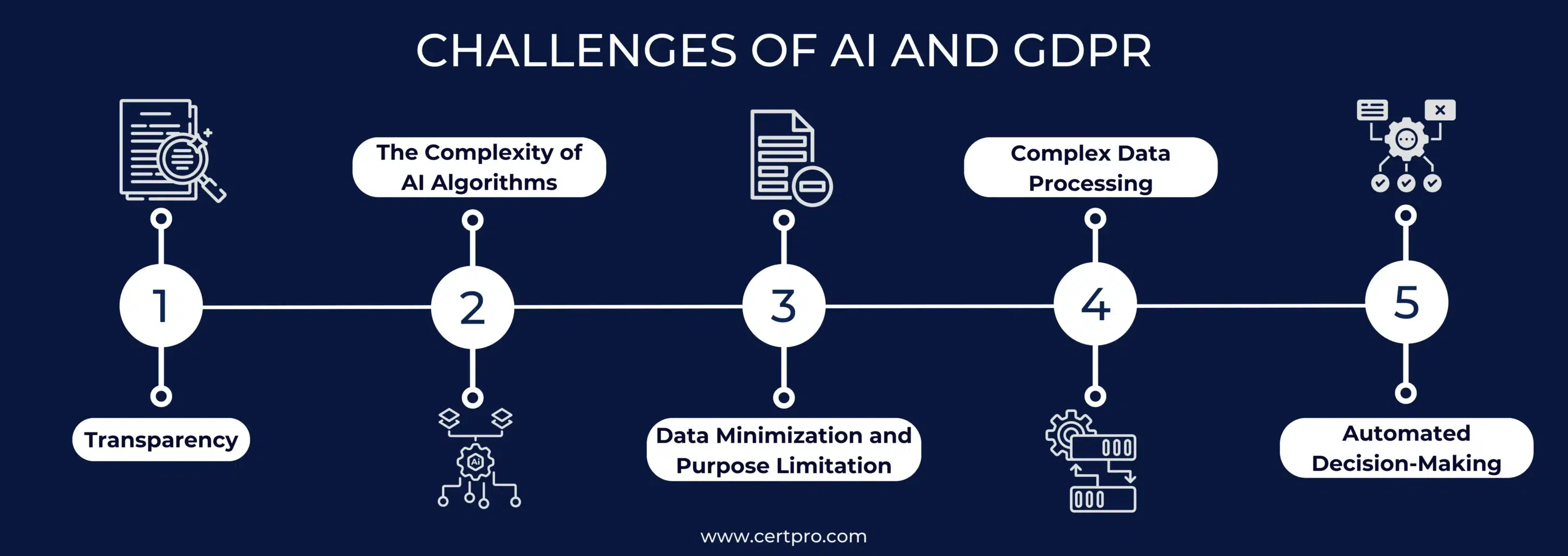The European Union’s General Data Protection Regulation offers a legal data protection and privacy framework. As Artificial Intelligence continues to expand across industries in modern technology, the concept of AI and GDPR becomes relevant. In 1950, researchers developed a machine that might stimulate human intelligence. At present, aggressive progress in AI makes it an integral part of our society. Thus, AI is now widely used in finance, transportation, healthcare, and entertainment industries. Every technology has specific opportunities and restrictions similar to AI. AI relies on data, which increases the concern. Thus, it is necessary to ensure that AI systems follow data privacy laws. The GDPR AI regulation confirms that data collection and consent are error-free and emphasize privacy and protection.
On 25th June 2025, the European Parliament published a study on the impact of GDPR on AI. The study explained how AI is regulated within the GDPR and recognized how AI fits into the GDPR’s conceptual framework. Therefore, based on this study, the EU proposed and developed an EU AI Act to make AI reliable and transparent. This article will discuss how AI helps GDPR compliance, the challenges of AI and GDPR compliance, and the best practices to comply with AI and GDPR.
AI Can Revolutionize GDPR Compliance
GDPR controls personal data and offers collection, processing, and storage guidance. AI systems process massive amounts of data to enhance their function. Thus, it is necessary to consider the GDPR principles and rights before incorporating AI.
Legal Basis for Data Processing: In GDPR AI regulations, if your company uses AI to process personal data, the legal basis that applies to the processing must be checked. Hence, AI relies on consent and ensures that the consent is free from discrimination and biases.
Data Minimization: AI systems should collect and process personal data necessary to accomplish the intended purpose. Therefore, personal data processing must be restricted and only accessed if required. Similarly, in GDPR, access to personal data is subject to restriction and requires authorization. Thus, AI and GDPR compliance can be an excellent option for your company for data minimization.
Anonymization and Pseudonymization: GDPR emphasizes using pseudonymization and anonymization techniques to safeguard personal data for privacy. The process reduces the risk of re-identification of personal data. Thus, both methods are essential for handling personal data in AI systems.
Storage Limitation: AI systems that handle personal information must keep correct and up-to-date records. In AI and GDPR, data is the prime concern for continuing the business.
Right to Information: GDPR bases the decision-making process solely on automated processing, which legally affects data handling. Hence, the AI GDPR compliance process reduces the consequences of the processing while using.
Automating Data Protection: One of the hardest things for businesses to do when following GDPR is to keep track of and protect vast amounts of personal data. This is where AI can be helpful. AI-powered data protection tools can instantly look through and sort data, find important information, and protect it with the proper security measures. Hence, this can help companies follow GDPR’s rules on keeping data as small as possible and keeping information private.
Enhancing Data Security: AI can help improve data security by finding and stopping possible data breaches. AI-powered security tools can help to find potential risks and take action to stop data breaches before they happen.
Streamlining Data Subject Requests: Under GDPR, people can change or delete their data. Businesses may need to spend much time and money on this process, especially if they have many customers. Thus, AI-driven chatbots can speed up this process by automatically handling requests from data subjects. They can check the person’s name, get their information, and do what needs to be done based on the request, all without any help from a person.
Security and Accountability: Companies need to be in charge of how their AI systems handle data and ensure that AI systems that deal with personal data have security tools to keep that data safe. In addition, these companies should take other technical and organizational steps appropriate for the risk their handling activities offer.
Rights of Individuals: AI systems must respect the rights granted under GDPR rules. Therefore, the rules ensure secure access to data and prevent unauthorized access. Again, GDPR prohibits subjecting to automated decision-making unless the expectation applies.
Challenges of AI and GDPR
AI is developing rapidly and interfering with our daily lives. Therefore, organizations must understand its importance in ensuring data privacy. Some of the common challenges related to AI are:
Transparency: Organizations must have clear guidance in AI for managing personal data and making decisions. Therefore, both AI and GDPR require sufficient monitoring processes to manage privacy. Thus, it helps maintain transparency in the process and avoids the risks of discrimination and bias.
The Complexity of AI Algorithms: Algorithms can be complicated to describe clearly and understandably. In addition, AI models are continuously upgrading and adapting the data for better functioning. AI systems can learn from biased input and make decisions. Thus, providing biased choices can raise ethical issues. Hence, the process needs careful monitoring while AI processes personal data.
Data Minimization and Purpose Limitation: Organizations should process minimum personal data for a particular operation. Therefore, AI systems should understand what data is necessary for training and decision-making. This helps reduce data exposure, maintain privacy concerns, and adhere to data privacy.
Complex Data Processing: Large datasets may be needed to get the most out of some AI models in terms of speed and accuracy. Because AI models require a lot of data to learn, strict efforts to reduce data can only sometimes work. AI systems may also find trends or links in data that the person in charge of the data did not plan or expect. Hence, following the purpose limitation principle might be tricky because new data methods might emerge.
Automated Decision-Making: GDPR prohibits decisions based only on automatic processing that legally affect the data subject. Hence, the data controller must take the proper steps if the decision is needed to carry out a contract or is based on consent. This includes giving the data subject the right to ask the controller to act personally, to say what they think, and to challenge the decision.

AI Practices to Comply with GDPR
It is essential to set up AI policies that are aligned with GDPR rules.
Design: Data security and privacy are essential at the early stage of AI development, so privacy is the top priority of the AI lifecycle. Thus, implementing data minimization and purpose limitation avoids collecting enormous data. Again, clear and transparent data governance standards for AI must be maintained.
Transparent Data Processing: It is essential to inform individuals how AI algorithms will utilize their data. Consequently, clear terms of service should be provided on personal data protection.
Purpose Limitation: Collect the necessary information and ensure that the AI systems process data. Thus, ensure the AI system’s data processing is consistent with the original stated purposes.
Data Security: Organizations must implement robust encryption and secure data-handling processes to safeguard personal information during AI training. In addition, a routine security audit identifies the vulnerabilities and risks in the process. The organization must implement suitable authorization processes for data access.
Data Protection Impact Assessments: Conduct DPIAs according to the GDPR for AI projects with high-risk processing operations, like those that could have serious privacy effects, use new technologies, or handle private data. Before implementing, you should look at any possible privacy problems and find ways to fix them. Hence, you should also ensure that your AI systems meet the standards of the GDPR.
Consent Management: Establish mechanisms to facilitate the recording and managing consent preferences, allowing individuals to effortlessly modify or revoke their consent whenever personal data is collected or processed for AI systems, particularly for automated decision-making. Where applicable, obtaining the necessary legal support and the valid consent of data subjects is crucial.
Right to Information: Providing individuals with sufficient information about how their data is handled and processed is crucial. In addition, you should offer justifications for AI-driven decision-making processes.
Data Subject Rights and Safeguards: Establish mechanisms for human intervention in automated decision-making that are compliant with the GDPR, including an appeal procedure and the ability for data subjects to convey their perspective or object to AI-driven decisions. Thus, GDPR AI regulation helps safeguard the data.
Training and Awareness: Educating employees and stakeholders regarding the AI development and deployment process is essential. Basic ideas about the GDPR requirements and ethical use of AI are also beneficial. They help foster a culture of data privacy and responsible use of AI.
Monitoring and Accountability: Organizations must implement continuous monitoring processes to maintain GDPR compliance and AI systems. Thus, it helps identify vulnerabilities and ethical use of AI. In this context, the appointment of a Data Protection Officer can assist with supervision.

CLOSING THOUGHTS
The GDPR dramatically affects AI technologies’ creation, use, and application. It emphasizes people’s privacy and rights and sets strict rules for using personal data. When organizations use AI for handling, they should follow the GDPR’s rules and focus on risks. It is important to remember that the EU AI Act will also likely be implemented, giving AI systems more specific rules. Thus, AI and GDPR are now essential to discussing and understanding the process. Again, the Artificial Intelligence Act stated that the GDPR is a necessary current subject. The suggested rule would stop the creation and use of AI systems that are dangerous to people’s rights, safety, and ways of making a living. In the same way as the GDPR does, these rules encourage companies to consider privacy and ethics issues during development.
FAQ
What is the impact of GDPR on AI?
It imposes strict guidelines on data privacy and protection. Thus, organizations must ensure AI systems adhere to GDPR principles.
How can AI help in data protection?
It has predictive tools built in. Thus, computers can guess what security breaches will happen before the incident occurs. This step can help businesses stay ahead of cyber dangers.
How will the GDPR impact machine learning?
GDPR requires companies to make decisions based on automated processing. Thus, it offers helpful information about how it works and explains what the processing is for and what it’s supposed to do.
How does GDPR affect technology?
The GDPR gives tech users certain rights, such as the power to control and view their data and the option to have their data deleted. Companies must now use safety tools like encryption to protect users as much as possible in case of a data breach.
What are the EU's proposed regulations on AI?
Laws don’t allow uses of AI that are “unacceptable” in terms of how dangerous they are. These apps have “social scoring” systems that rank people by collecting and analyzing their data. This helps with predictive policing and recognizing emotions at work and in schools.

About the Author
Abhijith Rajesh
Abhijith Rajesh is an Executive Team Lead at CertPro, specializing in ISO 27001, SOC2, GDPR, and other Information Security Compliance standards. He leads a dedicated team, ensuring the delivery of top-tier information security solutions. Abhijith excels in managing projects, optimizing security frameworks, and guiding clients through the complexities of the ever-evolving threat landscape.
NAVIGATING DATA PRIVACY FRAMEWORKS: A COMPREHENSIVE GUIDE
Globalization has intense effects on business functioning and scaling. In today's digital world, companies are generating an unprecedented rate of data that requires protection from emerging cyber threats. In addition, recurring data breaches and privacy concerns make...
BUSINESS NON-COMPLIANCE: THE HIDDEN FINANCIAL AND OPERATIONAL COSTS
Businesses are always in a dilemma regarding whether or not to be compliant. Most companies think that compliance will problematize their operating process. However, highly regulated industries like financial and healthcare services meet the legal obligations for...
Security Frameworks: A Comprehensive Guide with 14 Examples
Technological advancements make cyberattacks more sophisticated and advanced. Hence, organizations must keep up with the latest cybersecurity frameworks in these complicated scenarios to sustain themselves in a dynamic threat environment. Different cybersecurity...




